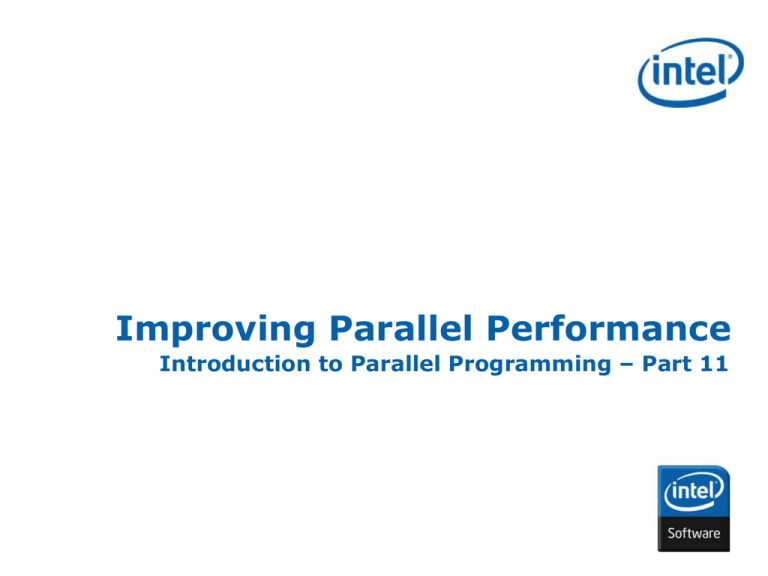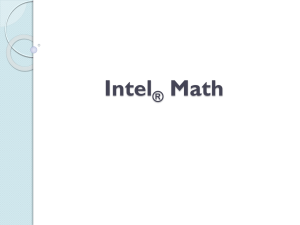
Improving Parallel Performance
Introduction to Parallel Programming – Part 11
INTEL CONFIDENTIAL
Review & Objectives
Previously:
Define speedup and efficiency
Use Amdahl’s Law to predict maximum speedup
At the end of this part you should be able to:
Explain why it can be difficult both to optimize
load balancing and maximize locality
Use loop fusion, loop fission, and loop inversion to
create or improve opportunities for parallel
execution
Copyright © 2009, Intel Corporation. All rights reserved.
Intel and the Intel logo are trademarks or registered trademarks of Intel Corporation or its subsidiaries in the United States
or other countries. * Other brands and names are the property of their respective owners.
2
General Rules of Thumb
Start with best sequential algorithm
Maximize locality
Copyright © 2009, Intel Corporation. All rights reserved.
Intel and the Intel logo are trademarks or registered trademarks of Intel Corporation or its subsidiaries in the United States
or other countries. * Other brands and names are the property of their respective owners.
3
Start with Best Sequential Algorithm
Don’t confuse “speedup” with “speed”
Speedup: ratio of program’s execution time on 1 core
to its execution time on p cores
What if start with inferior sequential algorithm?
Naïve, higher complexity algorithms
Easier to make parallel
Usually don’t lead to fastest parallel algorithm
Copyright © 2009, Intel Corporation. All rights reserved.
Intel and the Intel logo are trademarks or registered trademarks of Intel Corporation or its subsidiaries in the United States
or other countries. * Other brands and names are the property of their respective owners.
4
Maximize Locality
Temporal locality: If a processor accesses a memory
location, there is a good chance it will revisit that
memory location soon
Data locality: If a processor accesses a memory
location, there is a good chance it will visit a
nearby location soon
Programs tend to exhibit locality because they tend
to have loops indexing through arrays
Principle of locality makes cache memory worthwhile
Copyright © 2009, Intel Corporation. All rights reserved.
Intel and the Intel logo are trademarks or registered trademarks of Intel Corporation or its subsidiaries in the United States
or other countries. * Other brands and names are the property of their respective owners.
5
Parallel Processing and Locality
Multiple cores multiple caches
When a core writes a value, the system must ensure no core
tries to reference an obsolete value (cache coherence
problem)
A write by one core can cause the invalidation of another core’s
copy of cache line, leading to a cache miss
Rule of thumb: Better to have different cores manipulating
totally different chunks of arrays
We say a parallel program has good locality if cores’ memory
writes tend not to interfere with the work being done by
other cores
Copyright © 2009, Intel Corporation. All rights reserved.
Intel and the Intel logo are trademarks or registered trademarks of Intel Corporation or its subsidiaries in the United States
or other countries. * Other brands and names are the property of their respective owners.
6
Example: Array Initialization
for (i = 0; i < N; i++) a[i] = 0;
Terrible allocation of work to processors
0 1 2 3 0 1 2 3 0 1 2 3 0 1 2 3 0 1 2 3 0 1 2 3
Better allocation of work to processors...
0 0 0 0 0 0 1 1 1 1 1 1 2 2 2 2 2 2 3 3 3 3 3 3
unless sub-arrays map to same cache lines!
Copyright © 2009, Intel Corporation. All rights reserved.
Intel and the Intel logo are trademarks or registered trademarks of Intel Corporation or its subsidiaries in the United States
or other countries. * Other brands and names are the property of their respective owners.
7
Loop Transformations
Loop fission
Loop fusion
Loop inversion
Copyright © 2009, Intel Corporation. All rights reserved.
Intel and the Intel logo are trademarks or registered trademarks of Intel Corporation or its subsidiaries in the United States
or other countries. * Other brands and names are the property of their respective owners.
8
Loop Fission
Begin with single loop having loop-carried
dependence
Split loop into two or more loops
New loops can be executed in parallel
Copyright © 2009, Intel Corporation. All rights reserved.
Intel and the Intel logo are trademarks or registered trademarks of Intel Corporation or its subsidiaries in the United States
or other countries. * Other brands and names are the property of their respective owners.
9
Before Loop Fission
float *a, *b;
int i;
for (i = 1; i < N; i++) {
if (b[i] > 0.0) a[i] = 2.0 * b[i]; Perfectly
parallel
else a[i] = 2.0 * fabs(b[i]);
b[i] = a[i-1]; Loop-carried dependence
}
Copyright © 2009, Intel Corporation. All rights reserved.
Intel and the Intel logo are trademarks or registered trademarks of Intel Corporation or its subsidiaries in the United States
or other countries. * Other brands and names are the property of their respective owners.
10
After Loop Fission
#pragma omp parallel
{
#pragma omp for
for (i = 1; i < N; i++) {
if (b[i] > 0.0) a[i] = 2.0 * b[i];
else a[i] = 2.0 * fabs(b[i]);
}
#pragma omp for
for (i = 1; i < N; i++)
b[i] = a[i-1];
}
Copyright © 2009, Intel Corporation. All rights reserved.
Intel and the Intel logo are trademarks or registered trademarks of Intel Corporation or its subsidiaries in the United States
or other countries. * Other brands and names are the property of their respective owners.
11
Loop Fission and Locality
Another use of loop fission is to increase data locality
Before fission, nested loops reference too many data
values, leading to poor cache hit rate
Break nested loops into multiple nested loops
New nested loops have higher cache hit rate
Copyright © 2009, Intel Corporation. All rights reserved.
Intel and the Intel logo are trademarks or registered trademarks of Intel Corporation or its subsidiaries in the United States
or other countries. * Other brands and names are the property of their respective owners.
12
Before Fission
for (i = 0; i < list_len; i++)
for (j = prime[i]; j < N; j += prime[i])
marked[j] = 1;
marked
Copyright © 2009, Intel Corporation. All rights reserved.
Intel and the Intel logo are trademarks or registered trademarks of Intel Corporation or its subsidiaries in the United States
or other countries. * Other brands and names are the property of their respective owners.
13
After Fission
for (k = 0; k < N; k += CHUNK_SIZE)
for (i = 0; i < list_len; i++) {
start = f(prime[i], k);
end = g(prime[i], k);
for (j = start; j < end; j += prime[i])
marked[j] = 1;
}
marked
etc.
Copyright © 2009, Intel Corporation. All rights reserved.
Intel and the Intel logo are trademarks or registered trademarks of Intel Corporation or its subsidiaries in the United States
or other countries. * Other brands and names are the property of their respective owners.
14
Loop Fusion
The opposite of loop fission
Combine loops increase grain size
Copyright © 2009, Intel Corporation. All rights reserved.
Intel and the Intel logo are trademarks or registered trademarks of Intel Corporation or its subsidiaries in the United States
or other countries. * Other brands and names are the property of their respective owners.
15
Before Loop Fusion
float *a, *b, x, y;
int i;
...
for (i = 0; i < N; i++) a[i] = foo(i);
x = a[N-1] – a[0];
for (i = 0; i < N; i++) b[i] = bar(a[i]);
y = x * b[0] / b[N-1];
Functions foo and bar are side-effect free.
Copyright © 2009, Intel Corporation. All rights reserved.
Intel and the Intel logo are trademarks or registered trademarks of Intel Corporation or its subsidiaries in the United States
or other countries. * Other brands and names are the property of their respective owners.
16
After Loop Fusion
#pragma omp parallel for
for (i = 0; i < N; i++) {
a[i] = foo(i);
b[i] = bar(a[i]);
}
x = a[N-1] – a[0];
y = x * b[0] / b[N-1];
Now one barrier instead of two
Copyright © 2009, Intel Corporation. All rights reserved.
Intel and the Intel logo are trademarks or registered trademarks of Intel Corporation or its subsidiaries in the United States
or other countries. * Other brands and names are the property of their respective owners.
17
Loop Coalescing Example
#define N 23
#define M 1000
. . .
for (k = 0; k < N; k++)
for (j = 0; j < M; j++)
w_new[k][j] = DoSomeWork(w[k][j], k, j);
Prime number of iterations will never be perfectly
load balanced
Parallelize inner loop? Are there enough iterations to
overcome overhead?
Copyright © 2009, Intel Corporation. All rights reserved.
Intel and the Intel logo are trademarks or registered trademarks of Intel Corporation or its subsidiaries in the United States
or other countries. * Other brands and names are the property of their respective owners.
18
Loop Coalescing Example
#define N 23
#define M 1000
. . .
for (kj = 0; kj < N*M; kj++) {
k = kj / M;
j = kj % M;
w_new[k][j] = DoSomeWork(w[k][j], k, j);
}
Larger number of iterations gives better opportunity for load
balance and hiding overhead
DIV and MOD are overhead
Copyright © 2009, Intel Corporation. All rights reserved.
Intel and the Intel logo are trademarks or registered trademarks of Intel Corporation or its subsidiaries in the United States
or other countries. * Other brands and names are the property of their respective owners.
19
Loop Inversion
Nested for loops may have data dependences that
prevent parallelization
Inverting the nesting of for loops may
Expose a parallelizable loop
Increase grain size
Improve parallel program’s locality
Copyright © 2009, Intel Corporation. All rights reserved.
Intel and the Intel logo are trademarks or registered trademarks of Intel Corporation or its subsidiaries in the United States
or other countries. * Other brands and names are the property of their respective owners.
20
Loop Inversion Example
for (j = 1; j < n; j++)
for (i = 0; i < m; i++)
a[i][j] = 2 * a[i][j-1];
1
5
9
13
...
2
6
10
14
...
3
7
11
15
...
4
8
12
16
...
Copyright © 2009, Intel Corporation. All rights reserved.
Intel and the Intel logo are trademarks or registered trademarks of Intel Corporation or its subsidiaries in the United States
or other countries. * Other brands and names are the property of their respective owners.
21
Before Loop Inversion
for (j = 1; j < n; j++)
#pragma omp parallel for
Can execute
for (i = 0; i < m; i++)
inner loop in
a[i][j] = 2 * a[i][j-1]; parallel, but
grain size small
...
...
...
...
Copyright © 2009, Intel Corporation. All rights reserved.
Intel and the Intel logo are trademarks or registered trademarks of Intel Corporation or its subsidiaries in the United States
or other countries. * Other brands and names are the property of their respective owners.
22
Before Loop Inversion
for (j = 1; j < n; j++)
#pragma omp parallel for
Can execute
for (i = 0; i < m; i++)
inner loop in
a[i][j] = 2 * a[i][j-1]; parallel, but
grain size small
...
...
...
...
Copyright © 2009, Intel Corporation. All rights reserved.
Intel and the Intel logo are trademarks or registered trademarks of Intel Corporation or its subsidiaries in the United States
or other countries. * Other brands and names are the property of their respective owners.
23
Before Loop Inversion
for (j = 1; j < n; j++)
#pragma omp parallel for
Can execute
for (i = 0; i < m; i++)
inner loop in
a[i][j] = 2 * a[i][j-1]; parallel, but
grain size small
...
...
...
...
Copyright © 2009, Intel Corporation. All rights reserved.
Intel and the Intel logo are trademarks or registered trademarks of Intel Corporation or its subsidiaries in the United States
or other countries. * Other brands and names are the property of their respective owners.
24
Before Loop Inversion
for (j = 1; j < n; j++)
#pragma omp parallel for
Can execute
for (i = 0; i < m; i++)
inner loop in
a[i][j] = 2 * a[i][j-1]; parallel, but
grain size small
...
...
...
...
Copyright © 2009, Intel Corporation. All rights reserved.
Intel and the Intel logo are trademarks or registered trademarks of Intel Corporation or its subsidiaries in the United States
or other countries. * Other brands and names are the property of their respective owners.
25
Before Loop Inversion
for (j = 1; j < n; j++)
#pragma omp parallel for
Can execute
for (i = 0; i < m; i++)
inner loop in
a[i][j] = 2 * a[i][j-1]; parallel, but
grain size small
...
...
...
...
Copyright © 2009, Intel Corporation. All rights reserved.
Intel and the Intel logo are trademarks or registered trademarks of Intel Corporation or its subsidiaries in the United States
or other countries. * Other brands and names are the property of their respective owners.
26
After Loop Inversion
#pragma omp parallel for
for (i = 0; i < m; i++)
for (j = 1; j < n; j++)
a[i][j] = 2 * a[i][j-1];
Can execute
outer loop in
parallel
...
...
...
...
Copyright © 2009, Intel Corporation. All rights reserved.
Intel and the Intel logo are trademarks or registered trademarks of Intel Corporation or its subsidiaries in the United States
or other countries. * Other brands and names are the property of their respective owners.
27
References
Rohit Chandra, Leonardo Dagum, Dave Kohr, Dror
Maydan, Jeff McDonald, and Ramesh Menon,
Parallel Programming in OpenMP, Morgan
Kaufmann (2001).
Peter Denning, “The Locality Principle,” Naval
Postgraduate School (2005).
Michael J. Quinn, Parallel Programming in C with MPI
and OpenMP, McGraw-Hill (2004).
Copyright © 2009, Intel Corporation. All rights reserved.
Intel and the Intel logo are trademarks or registered trademarks of Intel Corporation or its subsidiaries in the United States
or other countries. * Other brands and names are the property of their respective owners.
28






